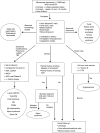Approach to Persistent Microscopic Hematuria in Children
- PMID: 35369549
- PMCID: PMC8815596
- DOI: 10.34067/KID.0003222020
Approach to Persistent Microscopic Hematuria in Children
Abstract
Persistent isolated microscopic hematuria is relatively common in pediatric practice, affecting around 0.25% of children. Isolated microscopic hematuria can be caused by a myriad of potentially benign or serious causes, including urologic issues; kidney stones; glomerular diseases, including disorders of the glomerular basement membrane; hematologic abnormalities; and others. The challenge for the pediatrician or pediatric nephrologist is to distinguish children with potentially progressive forms of kidney disease versus other causes while minimizing cost and inconvenience for the child and family. This manuscript will review the multiple potential causes of microscopic hematuria and provide a framework for the initial evaluation and monitoring of such patients.
Keywords: Alport syndrome; IgA nephropathy; IgA vasculitis; glomerular and tubulointerstitial diseases; hematuria; hypercalciuria; pediatric nephrology.
Copyright © 2020 by the American Society of Nephrology.
Conflict of interest statement
All authors have nothing to disclose.
Figures


References
-
- Vehaskari VM, Rapola J, Koskimies O, Savilahti E, Vilska J, Hallman N: Microscopic hematuria in school children: Epidemiology and clinicopathologic evaluation. J Pediatr 95: 676–684, 1979 - PubMed
-
- Vivante A, Afek A, Frenkel-Nir Y, Tzur D, Farfel A, Golan E, Chaiter Y, Shohat T, Skorecki K, Calderon-Margalit R: Persistent asymptomatic isolated microscopic hematuria in Israeli adolescents and young adults and risk for end-stage renal disease. JAMA 306: 729–736, 2011 - PubMed
-
- American Academy of Pediatrics—Section on Nephrology and the American Society of Pediatric Nephrology: Choosing wisely: Five things physicians and patients should question, 2018. Available at: https://www.choosingwisely.org/societies/american-academy-of-pediatrics-.... Accessed June 10, 2020
-
- Trachtman H, Weiss RA, Bennett B, Greifer I: Isolated hematuria in children: Indications for a renal biopsy. Kidney Int 25: 94–99, 1984 - PubMed
-
- Feng CY, Xia YH, Wang WJ, Xia J, Fu HD, Wang X, Shen HJ, Qian GL, Liu AM, Mao JH: Persistent asymptomatic isolated hematuria in children: Clinical and histopathological features and prognosis. World J Pediatr 9: 163–168, 2013 - PubMed
Publication types
MeSH terms
LinkOut - more resources
Full Text Sources
Miscellaneous

